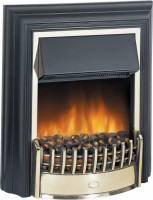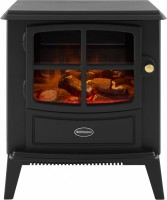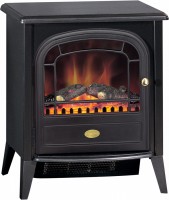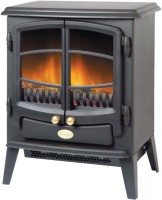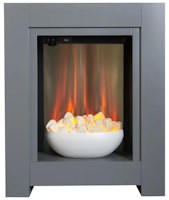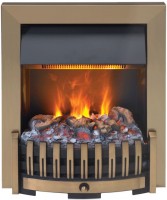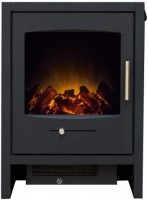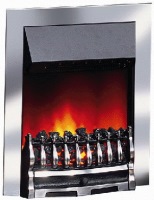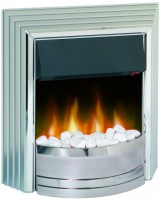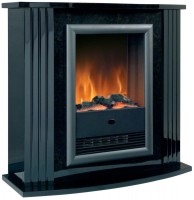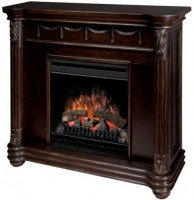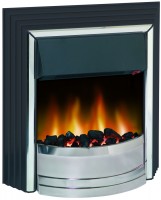Electric Fireplaces Dimplex
All models Advanced filters → |
You might be interested in
Electric Fireplaces: specifications, types
Type
— Fireplace. This category includes classic electric fireplaces, in other words, devices that are not related to fireplace sets. Their distinctive feature is the ease of design — even models equipped with decorative panels have a relatively simple and discreet look, and in many cases, such panels are completely absent. Classic fireplaces are designed for those who do not need rich design; they will also be useful in cases where the necessary decor is already available at the installation site, and only the device itself is missing.
— Electric fire suite (fireplace set). Fireplace sets stand out primarily for their rich design: the design of such models includes not only a heating device but also a decorative frame with shelves, bas-reliefs, carvings, etc. Due to this, fireplace sets are much more expensive than classic ones. At the same time, there are practically no differences in functionality; except that there are fewer installation options for a device of this type — most are designed for either installation against the wall or corner mounting(see below). Note that the design style of the fireplace set can be different — from imitation of wood "antique" to strict modern with the use of glass and metal.
— Electric fire suite (fireplace set). Fireplace sets stand out primarily for their rich design: the design of such models includes not only a heating device but also a decorative frame with shelves, bas-reliefs, carvings, etc. Due to this, fireplace sets are much more expensive than classic ones. At the same time, there are practically no differences in functionality; except that there are fewer installation options for a device of this type — most are designed for either installation against the wall or corner mounting(see below). Note that the design style of the fireplace set can be different — from imitation of wood "antique" to strict modern with the use of glass and metal.
Installation
The installation method provided by the design of the fireplace. In some models, there may be several such methods.
— Built-in. Fireplaces are designed to be installed in a wall niche — so that only the front is outside. Such devices take up a minimum of space and are very convenient in cramped conditions. On the other hand, the installation itself is quite complicated; it requires serious costs both in terms of money and time.
— Against wall. This type of installation involves placing it against a wall so that the back wall of the fireplace is in contact with this wall. Such devices take up a little more space than built-in ones, but they are noticeably easier to install.
— Wall mounted. Fireplaces with the possibility of hanging on the wall; are usually equipped with brackets or other devices for attaching to nails, hooks, etc. In addition, wall mounting is convenient because it leaves free space on the floor under the fireplace.
— Freestanding. Installation in the middle of the room, without contact with the walls. An environment in which such placement would be convenient is quite rare, and even less often there are situations when, from a practical point of view, a free-standing fireplace is necessary. Therefore, this type of installation has not received wide popularity, and most often it...is found as an additional option for models with installation against the wall (see above).
— Built-in. Fireplaces are designed to be installed in a wall niche — so that only the front is outside. Such devices take up a minimum of space and are very convenient in cramped conditions. On the other hand, the installation itself is quite complicated; it requires serious costs both in terms of money and time.
— Against wall. This type of installation involves placing it against a wall so that the back wall of the fireplace is in contact with this wall. Such devices take up a little more space than built-in ones, but they are noticeably easier to install.
— Wall mounted. Fireplaces with the possibility of hanging on the wall; are usually equipped with brackets or other devices for attaching to nails, hooks, etc. In addition, wall mounting is convenient because it leaves free space on the floor under the fireplace.
— Freestanding. Installation in the middle of the room, without contact with the walls. An environment in which such placement would be convenient is quite rare, and even less often there are situations when, from a practical point of view, a free-standing fireplace is necessary. Therefore, this type of installation has not received wide popularity, and most often it...is found as an additional option for models with installation against the wall (see above).
Corner installation
Technically, any fireplace can be installed in a corner, but this will not always be convenient. Therefore, models are produced that were originally designed for placement in a corner. This option can be optimal both from the point of view of the layout of the room and from the point of view of aesthetics. At the same time, in some models, the corner protruding in the rear part is made removable, which allows for side mounting.
Operating modes
Operating modes supported by the electric fireplace.
- Flame simulation. A decorative mode of operation of the fireplace implies an imitation of a flame without any heating. This function allows you to admire artificial fire when there is no need to heat the room - in hot weather or in a well-heated room where additional heat would be unnecessary.
- The sound of wood crackling. The operation of the electric fireplace in this mode is accompanied by the reproduction of the sound of natural burning wood, the key purpose of which is to enhance the atmosphere of a real fireplace. The basis of this sound is the crackling of the brazier. The sound is played by a special emulator. Depending on the model, the effect of crackling firewood can be adjusted in volume or turned off, but, in any case, this feature gives the electric fireplace more resemblance to a real hearth.
- Smoke effect (steam generator). Simulation of smoke from a flame in fireplaces usually is done with the help of an ultrasonic generator. Combined with the lighting and the design of the firebox imitating wood and coals, the steam “flame” looks very realistic and becomes almost indistinguishable from a real fire. The difference can only be seen up close and like the heat (when the heating function is on). A useful "side effect" of the steam generator is that it works as a humidifie...r. But such simulators must be constantly refuelled with water and periodically cleaned from salt deposits.
— Heating. The heating function provides the maximum similarity of the device to a real fireplace. It makes it possible not only to contemplate the beauty of an artificial flame but also to heat the serviced premises. In electric fireplaces, there can be either one heating mode or several with different levels of heating efficiency and power consumption.
- Flame simulation. A decorative mode of operation of the fireplace implies an imitation of a flame without any heating. This function allows you to admire artificial fire when there is no need to heat the room - in hot weather or in a well-heated room where additional heat would be unnecessary.
- The sound of wood crackling. The operation of the electric fireplace in this mode is accompanied by the reproduction of the sound of natural burning wood, the key purpose of which is to enhance the atmosphere of a real fireplace. The basis of this sound is the crackling of the brazier. The sound is played by a special emulator. Depending on the model, the effect of crackling firewood can be adjusted in volume or turned off, but, in any case, this feature gives the electric fireplace more resemblance to a real hearth.
- Smoke effect (steam generator). Simulation of smoke from a flame in fireplaces usually is done with the help of an ultrasonic generator. Combined with the lighting and the design of the firebox imitating wood and coals, the steam “flame” looks very realistic and becomes almost indistinguishable from a real fire. The difference can only be seen up close and like the heat (when the heating function is on). A useful "side effect" of the steam generator is that it works as a humidifie...r. But such simulators must be constantly refuelled with water and periodically cleaned from salt deposits.
— Heating. The heating function provides the maximum similarity of the device to a real fireplace. It makes it possible not only to contemplate the beauty of an artificial flame but also to heat the serviced premises. In electric fireplaces, there can be either one heating mode or several with different levels of heating efficiency and power consumption.
Max. heating area
The largest area of the room that the electric fireplace can effectively heat. In this case, the area is calculated for a standard ceiling height of 2.5 m; for rooms where this height is noticeably different, the effective heating area will be different. In such cases, it is possible to determine whether the power of the fireplace will be sufficient, based on the calculation for heating 2.5 cubic metres of air in the room requires a power of 100 watts. The volume of a room can be derived by multiplying the area by the height.
Max. power
The highest power consumed by an electric fireplace during operation. This parameter describes both the amount of electricity consumed (and, accordingly, the load on the power mains), and the amount of heat generated by the device and the size of the room in which it can be used. However, most manufacturers indicate the maximum heating area separately (see below). Nevertheless, if this parameter is unknown, it can be determined from the maximum power using the following formula: for effective heating of 1 m² of the area in a room with a standard ceiling height of 2.5 m is considered sufficient power of 100 watts.
Heating power
It is the heat output of the fireplace. With several intensity settings, the customer can choose the best option for each specific situation. For example, when returning to the house after a long absence, when the room has cooled down, the fireplace can be turned on at full power; if you just need to help the main heating system a little, it is better to use half the intensity so as not to overheat the air and not waste electricity; and so on.
Simulation mode power
The amount of energy consumed by the electric fireplace when operating in flame simulation mode (see "Operating modes"). Since in this mode, it is not necessary to spend energy on heating, the power consumption in it is noticeably lower. Its specific value significantly depends on the principle of flame simulation (see below).
Functions
- Temperature adjustment. This function allows you to optimally adjust the operation of the device to the necessary conditions by setting a specific value for the desired heating temperature. The vast majority of these models of heaters are equipped with electronic programmers with a display, less often with mechanical devices for accurately setting the temperature.
- Thermostat. A device for selecting the intensity of heating and maintaining the specified temperature limits in the served room with some slight fluctuations. Heaters with a thermostat automatically turn off when the set temperature level is reached and turn on again when it gets colder by a couple of degrees. Models of this order usually do not provide for the possibility of choosing a specific temperature, and thermostats in them are presented in the form of simple mechanical regulators of the heating intensity.
- Fan heater. The presence in the design of the fireplace of a special fan that supplies hot air from the device. Due to this, the room warms up faster than with natural convection (without a fan).
- Flame brightness adjustment. The ability to change the brightness of the flame visible in the "furnace" of the fireplace. This function allows you to customize the appearance of the device according to the mood and situation: for example..., in soft evening lighting, you can “mute” the fireplace so that it does not blind your eyes, and in bright light (for example, on a clear day) — you can make the flame brighter and more noticeable .
— Flame intensity adjustment . The ability to change the intensity of the flame imitated by the fireplace — so that it looks calm or stormy.
- Flame colour adjustment. Another setting for the decor of the room. It allows you to change the colour of the flame, which allows you to set both a cold blue fire and a hot red one. However, other combinations of colour shades of the flame can be used in fireplaces. The colour palette of fire imitation depends on the specific model of the fireplace. Some models allow you to use the automatic change of the flame palette, which is characteristic of the natural combustion cycle, from lighting a fire to smouldering coals. In advanced-class fireplaces, in addition to adjusting the colour palette of the flame, the ability to adjust the intensity and brightness of combustion is added.
— Air purification filter. The presence of a filter in the design of the fireplace, which cleans the air from various impurities. True, the efficiency of such cleaning is usually not as high as when using special equipment; on the other hand, intensive filtration is not required in residential areas. The filter can be designed both to remove small particles (smoke, dust) and to fight odours.
— Air humidification. The ability of the fireplace to humidify the air. The most comfortable relative humidity for a person is considered to be about 60-70%. However, during the cold season, the humidity in residential premises may drop. Humidifiers are used to restore optimal conditions.
- Shutdown timer. This timer provides automatic shutdown of the electric fireplace after the time set by the user. Thanks to this, you can, for example, turn on the device in flame simulation mode instead of a night light, set a timer and go to bed without worrying about having to turn off the fireplace manually.
— Open window sensor. A special sensor allows the device to automatically recognize when a window/vent is opened for ventilation. In the process of ventilating the room, the fireplace either turns off completely or goes into the most economical operation mode. This function allows you to save energy, because during the ventilation process, room heat will still evaporate to the street. The very fact of ventilation is most often recorded by the programmer. For this, automation can use either traditional magnetic contact sensors or draft sensors (inflow of cold air).
- Thermostat. A device for selecting the intensity of heating and maintaining the specified temperature limits in the served room with some slight fluctuations. Heaters with a thermostat automatically turn off when the set temperature level is reached and turn on again when it gets colder by a couple of degrees. Models of this order usually do not provide for the possibility of choosing a specific temperature, and thermostats in them are presented in the form of simple mechanical regulators of the heating intensity.
- Fan heater. The presence in the design of the fireplace of a special fan that supplies hot air from the device. Due to this, the room warms up faster than with natural convection (without a fan).
- Flame brightness adjustment. The ability to change the brightness of the flame visible in the "furnace" of the fireplace. This function allows you to customize the appearance of the device according to the mood and situation: for example..., in soft evening lighting, you can “mute” the fireplace so that it does not blind your eyes, and in bright light (for example, on a clear day) — you can make the flame brighter and more noticeable .
— Flame intensity adjustment . The ability to change the intensity of the flame imitated by the fireplace — so that it looks calm or stormy.
- Flame colour adjustment. Another setting for the decor of the room. It allows you to change the colour of the flame, which allows you to set both a cold blue fire and a hot red one. However, other combinations of colour shades of the flame can be used in fireplaces. The colour palette of fire imitation depends on the specific model of the fireplace. Some models allow you to use the automatic change of the flame palette, which is characteristic of the natural combustion cycle, from lighting a fire to smouldering coals. In advanced-class fireplaces, in addition to adjusting the colour palette of the flame, the ability to adjust the intensity and brightness of combustion is added.
— Air purification filter. The presence of a filter in the design of the fireplace, which cleans the air from various impurities. True, the efficiency of such cleaning is usually not as high as when using special equipment; on the other hand, intensive filtration is not required in residential areas. The filter can be designed both to remove small particles (smoke, dust) and to fight odours.
— Air humidification. The ability of the fireplace to humidify the air. The most comfortable relative humidity for a person is considered to be about 60-70%. However, during the cold season, the humidity in residential premises may drop. Humidifiers are used to restore optimal conditions.
- Shutdown timer. This timer provides automatic shutdown of the electric fireplace after the time set by the user. Thanks to this, you can, for example, turn on the device in flame simulation mode instead of a night light, set a timer and go to bed without worrying about having to turn off the fireplace manually.
— Open window sensor. A special sensor allows the device to automatically recognize when a window/vent is opened for ventilation. In the process of ventilating the room, the fireplace either turns off completely or goes into the most economical operation mode. This function allows you to save energy, because during the ventilation process, room heat will still evaporate to the street. The very fact of ventilation is most often recorded by the programmer. For this, automation can use either traditional magnetic contact sensors or draft sensors (inflow of cold air).
Display
The presence of a display to show the settings of the electric fireplace.
Remote control
Availability in a set of delivery of an fireplace of the remote control. The purpose and advantages of this function are obvious: the fireplace settings can be controlled without approaching the device — roughly speaking, "without getting up from the couch." Note that the set of functions covered by the remote control may differ from those for which the built-in control panel is responsible — in other words, there may be more or less of them in the remote control, depending on the specific model. However, the remote control gives access to all basic functions.
Portal material
— MDF. It is a classic material for the manufacture of fireplace sets and other furniture. It is a wood-fibre board that can be made in different shapes and give any look. This material is highly environmentally friendly, lightweight and has good strength. The closest analogue is a chipboard, but unlike the latter, it has a finer-grained structure, and its surface is perfectly smooth. Also, this type of portal can be additionally covered with PVC film or eco-veneer, unlike models with veneered MDF, which use natural veneer.
— MDF with stone. Fireplaces made of the material described above — MDF, which is additionally lined with stone. This option gives an unusual antique look. MDF, like engineered stone, is one of the environmentally friendly materials.
— Veneered MDF. Another type of material directly related to MDF. Natural wood is quite expensive, so veneer from various types of wood is used. At the same time, the appearance is indistinguishable from a solid wooden frame, which is why this material is inherent in top-level fireplaces.
— Engineered stone. A kind of fireplace in which there was no place for MDF and it is completely made of stone. Engineered stone is created based on acrylic resins, this material is also called "acrylic stone". It is known for high durability and absolute environmental frie...ndliness, has a rather small weight, high reliability and durability. Frames made of engineered stone are outwardly indistinguishable from analogues made of real marble, granite or natural stone.
— MDF with stone. Fireplaces made of the material described above — MDF, which is additionally lined with stone. This option gives an unusual antique look. MDF, like engineered stone, is one of the environmentally friendly materials.
— Veneered MDF. Another type of material directly related to MDF. Natural wood is quite expensive, so veneer from various types of wood is used. At the same time, the appearance is indistinguishable from a solid wooden frame, which is why this material is inherent in top-level fireplaces.
— Engineered stone. A kind of fireplace in which there was no place for MDF and it is completely made of stone. Engineered stone is created based on acrylic resins, this material is also called "acrylic stone". It is known for high durability and absolute environmental frie...ndliness, has a rather small weight, high reliability and durability. Frames made of engineered stone are outwardly indistinguishable from analogues made of real marble, granite or natural stone.

